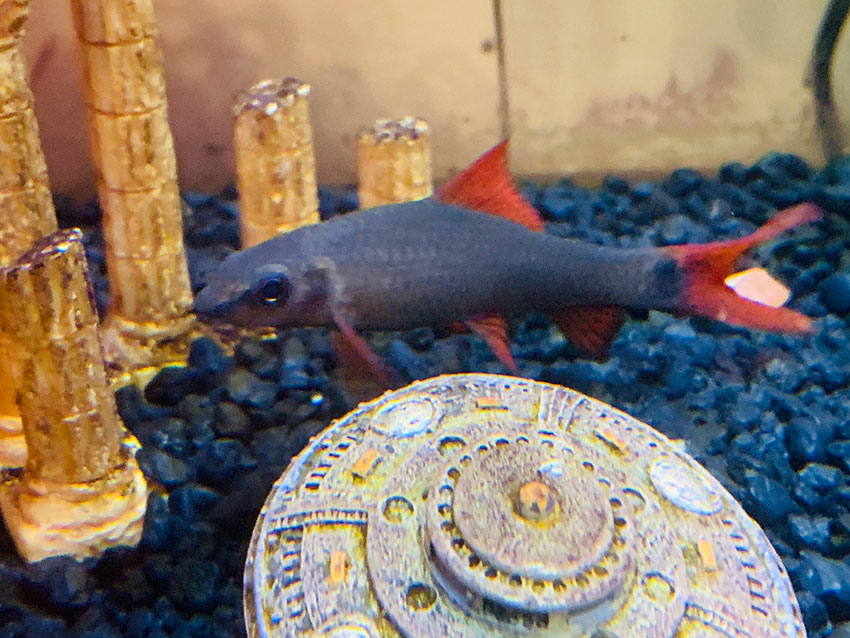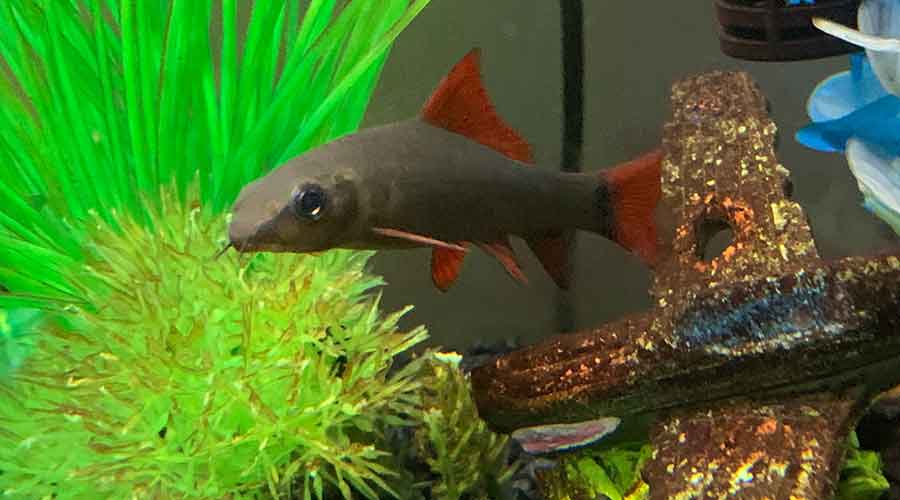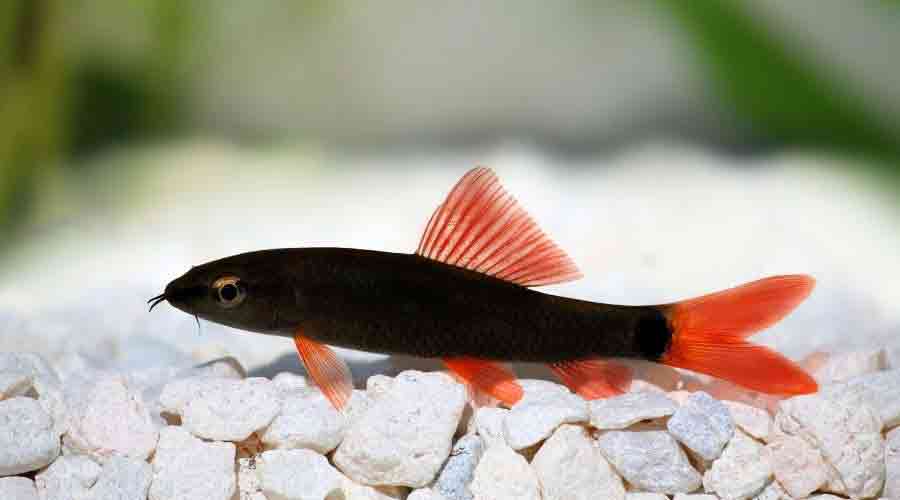Rainbow Shark, also known as Ruby Fin Shark, are beautiful tropical freshwater fish. They are one of my favorite freshwater fish, and I currently have one in my fish tank.
However, before you just load your fish tank up on Rainbow Sharks, you may want to know a few important points about them.
Let’s take a look.
Table of Contents
About
Colors
– Albino Rainbow Shark
Behavior
Water Conditions
Tank Size
Feeding
Tankmates
Recap
About Rainbow Shark

In short, the Rainbow Shark (Epalzeorhynchos frenatum) is a unique freshwater fish that is originally from Thailand. Rainbows are omnivores from the Cyprinidae family. Although beautiful fish, Rainbow Sharks are semi-aggressive fish. They like to swim near the bottom of the tank and eat algae. And, in case you were wondering, no, they are not actually sharks.
Lifespan: Up to 8 years
Color: Gray and orange
Fish Type: Freshwater Omnivore from the Cyprinidae family
Size: Up to 6 inches
Rainbow Shark Colors
Rainbow Sharks can look very similar to a red tail shark. However, they are, of course, a different type of fish. Red tail sharks typically have only a red tail and a black body, whereas a Rainbow Shark will have orange fins and a dark gray body.
When they are younger, determining the sex of the fish won’t be possible. However, as the fish ages, certain features will allow owners to determine the sex of the fish.
Rainbows that are females will have thicker bodies, and the male Rainbow will have lines going across their tales.
Albino Rainbow Sharks
Although they are rare, Albino Rainbow Shark do exist. These types of Rainbows usually match Rainbow Shark in all of the other ways, such as behavior. However, their bodies are white.
Behavior
When I first purchased my Rainbow Shark, he liked to swim around a little bit and hideout in plants and behind rocks. Now, a few years later, his behavior is quite a bit different.
Other than my blue crayfish, my Rainbow is one of my most favorite fish to watch. Unlike when I first got him, my Rainbow Shark is now very active in my fish tank. Although he will still hide out in my aquarium’s plants from time to time, he loves to swim quickly throughout the tank.
He moves swiftly and elegantly from one side of the tank to the other and from top to bottom. Also, like most Rainbow Shark, he is a bit aggressive and territorial. He doesn’t exactly try to eat my pet crayfish, or my other fish, a neon tetra, but, he has no problem nipping at both when he feels like it or if they try to take his food.
However, for the most part, my shark just likes to hang out near the bottom of my tank and nibble on algae.

Water Conditions for Rainbow Shark
Rainbows are considered hardy fish. However, like other fish, they should always be kept in a healthy environment. Before adding any fish to a fish tank, make sure the water properly cycles and that the water is also conditioned appropriately. Additionally, you’ll want to make sure that the water meets the requirements below.
- Water temperature – Between 74 and 79 degrees Fahrenheit
- pH – Mildly-acidic, between 6.0 and 7.0
- Water hardness (KH) – Between four and 10 dGH
With Rainbows, you’ll want to avoid sudden changes in pH levels. This can
Tank Size and Ornaments
You’ll see different recommendations about the optimal tank size for a Rainbow. However, based on my experience, ideally, I believe that a 55-gallon fish tank is best. In other cases, a smaller tank might work, but it’s not recommended and not best for the fish. The guys like to swim and need the room to do so, so give them space. If you don’t, you might find your Rainbow jumping for it.
Yep, these guys can jump. So also make sure that your tank lid is secure.
Also, this is a fish that can benefit from a tank that includes ornaments, rocks, and plants. These help keep the fish busy and distracted, which can cut down on these fish acting out against other fish within the tank.
Feeding
These fish are omnivores, and on top of that, they aren’t picky eaters. In the wild, they eat algae, decaying plants, animals, and lots of things that sit at the bottom of bodies of water.
It’s best to feed your Rainbow a wide variety of items. These items might include:
- Algae pellets
- Spinach
- Bloodworms
- Brine shrimp
- Fish flakes
For many Rainbow Sharks, you’ll notice that their tails and fins become more colorful when they are fed meat periodically. So be sure to switch up the menu for these guys and include some meat in their diets.
Tankmates
As stated earlier, Rainbow Sharks are very aggressive and territorial fish. And, for this reason, they can’t just be kept in an aquarium with any type of fish.
First, never keep a Rainbow Shark in the same tank with another Rainbow. This will most definitely be an issue.
Rainbow sharks like to swim on the bottom of the tank, so when considering other fish for your tank, think about fish that swim in the middle of the tank or at the top of the tank.
Also, it’s important to take into consideration personality types. For example, a shy little fish that swims on the bottom of the fish tank would never be a good tankmate for a Rainbow Shark. This would mean catfish probably wouldn’t be a good idea.
Another thing to take into account is the look of fish that you keep with a Rainbow. Never keep a Rainbow shark with any type of fish that looks similar. This means that Red Tail Shark and Bala Shark would not work.
Good Tankmaktes for Rainbow Sharks Include:
- Danios
- Rainbowfish
- Barbs (Tiger Barbs)
Rainbow Sharks: A Recap
In this blog, we looked at the Rainbow Shark. It’s an exciting fish that has to be cared for the right way. Rainbows are aggressive omnivores that aren’t too picky about their eating habits and will eat decaying meat and plant matter. Additionally, these are fish that need to be kept in the right sized tanks with the right type of tank mates.
If you plan on investing in a Rainbow Shark, make sure your tank is:
- A tank that is at least 55-gallons (suggested)
- Properly cycled
- Has conditioned water
- Includes a filtration system
- Contains ornaments and hideouts
- Includes the appropriate tankmates

